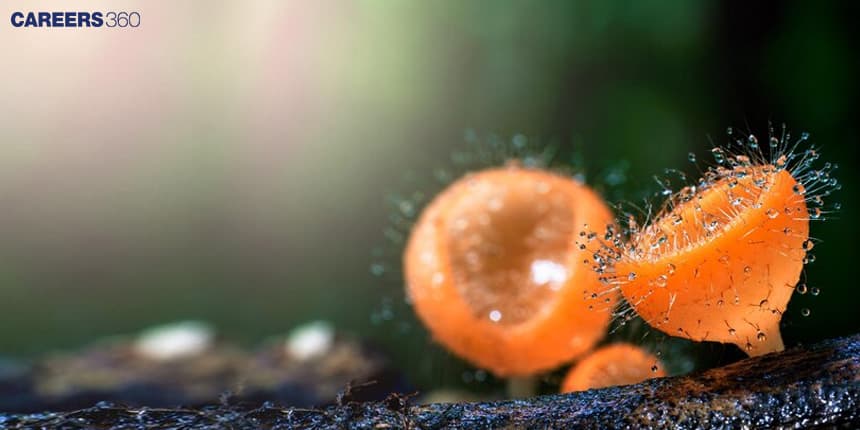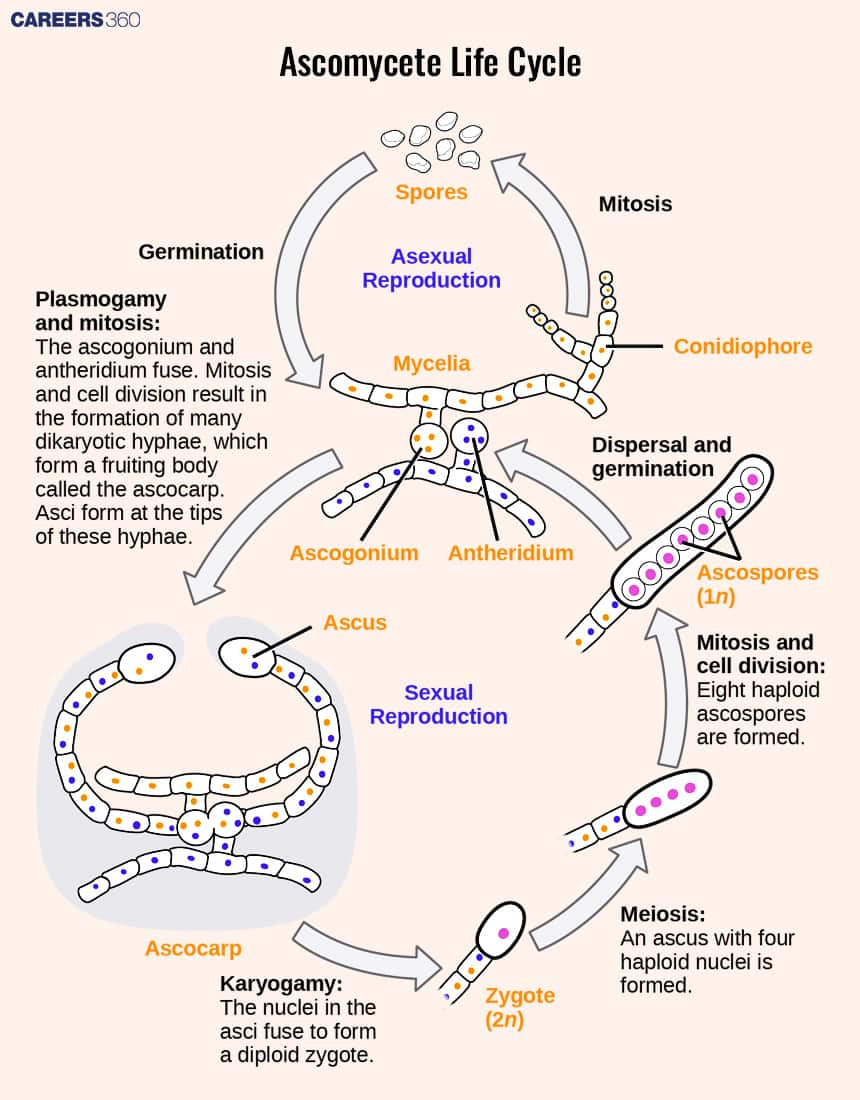Ascomycetes: Overview, Facts, Examples, Characteristics, Importance
Ascomycetes or sac fungi comprise a diverse, very broad group of fungi which constitute the phylum Ascomycota. The asci characterise Ascomycetes as they produce spores. These fungi have vital ecological and economic roles. Ascomycetes comprise yeasts and moulds, as well as the more complex forms including the morels and truffles. They play a key role in nutrient cycling as decomposers, are involved in lichens by forming mutualistic associations, and contain severe plant pathogens like Claviceps purpurea. This is part of the Biological Classification chapter in Biology.
NEET 2025: Mock Test Series | Syllabus | High Scoring Topics | PYQs
NEET Important PYQ's Subject wise: Physics | Chemistry | Biology
New: Meet Careers360 B.Tech/NEET Experts in your City | Book your Seat now
- Definition of Ascomycetes
- Major groups of Ascomycetes
- Ecological roles of Ascomycetes

Definition of Ascomycetes
Sac fungi, or ascomycetes, are a large, diverse and widespread group of fungi with a distinctive spore-bearing structure called the ascus. Ascospores are spores formed in the ascus. This group ranges from yeasts, and moulds to more complex multicellular organisms such as morels and truffles.
Ecologically, they play major roles associated with decomposition and thus are involved in organic matter breakdown and recycling nutrients. They have symbiotic relationships, like lichens with algae. They are used in the production of antibiotics such as penicillin, fermentation as in beers and bread, and contributions to achievements in biotechnology.
Also Read
Morphology of Ascomycetes
The Ascomycetes range from single-celled yeasts to complex multicellular moulds and morels; and characteristic members of this group, a mass of filamentous hyphae, called mycelium, is formed and provides the means for nutrient absorption and dissemination. However, the hyphal structure can be very different, with the protuberances ultimately affecting their ecological functions and relationships with other organisms.
A defining characteristic of the ascomycetes is their manner of ascospore formation. Spores that develop inside specialised sac-like structures are called asci. These ascospores show great diversity in shape, size, and ornamentation, contributing largely to species diversity and ecological adaptation. In such a manner, these ascospores can be dispersed through a variety of means, including wind, water, and animals, with carryover of ascomycete species into a variety of habitats.
Life Cycle of Ascomycetes
The ascomycetes have a complex cycle of life that considers both asexual and sexual reproduction. Thus, in asexual reproduction, mitosis produces conidia that serve to disperse them into colonizing new resident environments. In sexual reproduction, conjugated compatible hyphae give rise to the most characteristic structure of the Ascomycota which is the asci.
In the ascus, the haploid nuclei are coupled, producing karyogamy associated with meiosis, which generates ascospores. These ascospores are eventually released and dispersed, thus completing the sexual reproductive cycle of ascomycetes. This dual mode of reproduction increases their chances of adaptation and survival in a variety of ecological niches.
Life Cycle of an Ascomycete

Major groups of Ascomycetes
Saccharomycetes yeasts belong to the single-celled fungi. They are very popularly known for fermentation while changing sugar into alcohol plus carbon dioxide. This is mainly done by budding. Some of the basics are discussed below:
Eurotiomycetes Mushy moulds contain common genera such as Penicillium and Aspergillus that are used extensively in industry and are the source of antibiotics such as penicillin. Their reproduction is asexual by the production of conidia.
Sordariomycetes class contains many of the familiar fungi including Neurospora crassa has been the subject of extensive genetic and biochemical study owing to its ease of culture and well-defined genetics.
Lichens are organisms composed of fungi, mostly ascomycetes, which exist in mutualistic association with algae or cyanobacteria. These organisms show the importance attached to their ecological roles, which include soil creation and nitrogen fixation, among others in most ecosystems worldwide.
Ecological roles of Ascomycetes
Ascomycetes play their role in a variety of ways in the ecology of the ecosystem, health, and function. Some of the basic points about Ecological roles are discussed below:
- They decompose organic material and mediate nutrient cycling and soil development.
- Some ascomycetes genera are pathogens of plants, including pathogens from animals which are important in reducing agricultural productivity and biodiversity.
- A lot of ascomycetes live in symbiosis with algae or cyanobacteria inside the structure of different lichen species in soil stabilisation, nitrogen fixation, and the habitat of many organisms.
- Ascomycetes are quite known for the production of antibiotics such as penicillin, produced by Penicillium moulds, and completely revamped medicine in the fight against bacterial diseases.
- Ascomycetes play also an important role in biotechnological applications from enzyme production to bioremediation to hosts for genetic engineering.
- Ascomycetes play a very important role in the food industry, being responsible for fermentation processes that give rise to important products like cheese, bread, and alcoholic beverages.
Also Read
Recommended video for Ascomycetes:
Frequently Asked Questions (FAQs)
Ascomycetes or sac fungi, is a large and diverse group of fungi whose common characteristic that defines this group, is a reproductive structure the ascus, a sac-like, in which spores are produced.
Ascomycetes have a life cycle involving both asexual (conidia production) and sexual reproduction (ascospore formation within asci), enhancing their adaptability and survival.
Ascomycetes have several practical applications, they are used, for the production of antibiotics such as penicillin, and in the fermentation of beverages and bread; they also serve as hosts for biotechnological processes, including, the production of enzymes.
The life cycle of Ascomycetes includes both sexual and asexual reproduction. In asexual reproduction, there is the production of conidium. While in sexual reproduction, asci and ascospores formation takes place.
Diseases caused by Ascomycetes in humans and plants vary. Candidiasis is one such disease caused by Candida species in humans, and powdery mildew disease in plants. They have wide-ranging effects on agriculture and human health worldwide.
Also Read
30 Nov'24 12:23 PM
28 Nov'24 05:34 PM
25 Nov'24 05:18 PM
23 Nov'24 10:02 AM
22 Nov'24 01:59 PM
21 Nov'24 04:58 PM
16 Nov'24 01:58 PM

